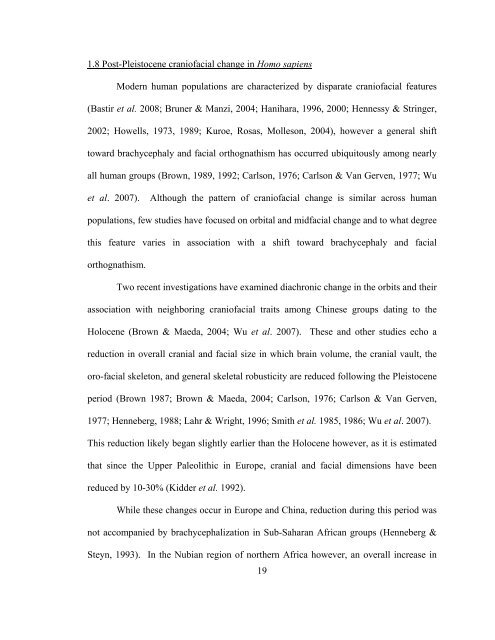modern variation and evolutionary change in the hominin eye orbit
modern variation and evolutionary change in the hominin eye orbit
modern variation and evolutionary change in the hominin eye orbit
Create successful ePaper yourself
Turn your PDF publications into a flip-book with our unique Google optimized e-Paper software.
1.8 Post-Pleistocene craniofacial <strong>change</strong> <strong>in</strong> Homo sapiensModern human populations are characterized by disparate craniofacial features(Bastir et al. 2008; Bruner & Manzi, 2004; Hanihara, 1996, 2000; Hennessy & Str<strong>in</strong>ger,2002; Howells, 1973, 1989; Kuroe, Rosas, Molleson, 2004), however a general shifttoward brachycephaly <strong>and</strong> facial orthognathism has occurred ubiquitously among nearlyall human groups (Brown, 1989, 1992; Carlson, 1976; Carlson & Van Gerven, 1977; Wuet al. 2007). Although <strong>the</strong> pattern of craniofacial <strong>change</strong> is similar across humanpopulations, few studies have focused on <strong>orbit</strong>al <strong>and</strong> midfacial <strong>change</strong> <strong>and</strong> to what degreethis feature varies <strong>in</strong> association with a shift toward brachycephaly <strong>and</strong> facialorthognathism.Two recent <strong>in</strong>vestigations have exam<strong>in</strong>ed diachronic <strong>change</strong> <strong>in</strong> <strong>the</strong> <strong>orbit</strong>s <strong>and</strong> <strong>the</strong>irassociation with neighbor<strong>in</strong>g craniofacial traits among Ch<strong>in</strong>ese groups dat<strong>in</strong>g to <strong>the</strong>Holocene (Brown & Maeda, 2004; Wu et al. 2007). These <strong>and</strong> o<strong>the</strong>r studies echo areduction <strong>in</strong> overall cranial <strong>and</strong> facial size <strong>in</strong> which bra<strong>in</strong> volume, <strong>the</strong> cranial vault, <strong>the</strong>oro-facial skeleton, <strong>and</strong> general skeletal robusticity are reduced follow<strong>in</strong>g <strong>the</strong> Pleistoceneperiod (Brown 1987; Brown & Maeda, 2004; Carlson, 1976; Carlson & Van Gerven,1977; Henneberg, 1988; Lahr & Wright, 1996; Smith et al. 1985, 1986; Wu et al. 2007).This reduction likely began slightly earlier than <strong>the</strong> Holocene however, as it is estimatedthat s<strong>in</strong>ce <strong>the</strong> Upper Paleolithic <strong>in</strong> Europe, cranial <strong>and</strong> facial dimensions have beenreduced by 10-30% (Kidder et al. 1992).While <strong>the</strong>se <strong>change</strong>s occur <strong>in</strong> Europe <strong>and</strong> Ch<strong>in</strong>a, reduction dur<strong>in</strong>g this period wasnot accompanied by brachycephalization <strong>in</strong> Sub-Saharan African groups (Henneberg &Steyn, 1993). In <strong>the</strong> Nubian region of nor<strong>the</strong>rn Africa however, an overall <strong>in</strong>crease <strong>in</strong>19
















